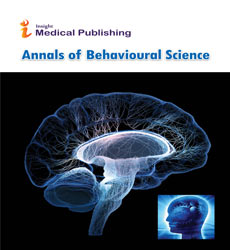Different Techniques for Behavioural Psychotherapy
Qu Tin
Qu Tin*
Department of Psychotherapy, Tohoku University, Sendai, China
- *Corresponding Author:
- Qu Tin
Department of Psychotherapy
Tohoku University
Sendai, China
E-mail: Qutin@gmail.com
Received Date: September 03, 2021; Accepted Date: September 17, 2021; Published Date: September 24, 2021
Citation: Tin Q (2021) Different Techniques for Behavioural Psychotherapy. Ann Behav Sci Vol.7 No.3:003.
Description
Behaviour therapy or behavioural psychotherapy may be a broad term pertaining to clinical psychotherapy that uses techniques derived from behaviourism and psychology. It looks at specific, learned behaviours and the way the environment or other people's mental states influences those behaviours and consists of techniques supported by learning theory, like respondent or operant conditioning. Behaviourists who practice these techniques are either behaviour analysts or cognitivebehavioural therapists. They tend to seem for treatment outcomes that are objectively measurable. Behaviour therapy doesn't involve one specific method, but it's a good range of techniques that will treat an individual's psychological problems.
Behavioural psychotherapy is sometimes juxtaposed with cognitive psychotherapy. While cognitive-behavioural therapy integrates aspects of both approaches, like cognitive restructuring, positive reinforcement, habituation (or desensitization), counterconditioning, and modelling.
Applied behaviour analysis (ABA) is that the application of behaviour analysis that focuses on functionally assessing how behaviour is influenced by the observable learning environment and the way to vary such behaviour through contingency management or exposure therapies, which are used throughout clinical behaviour analysis therapies or other interventions supported an equivalent learning principles.
Cognitive-behavioural therapy views cognition and emotions as preceding overt behaviour and implements treatment plans in psychotherapy to reduce the difficulty by managing competing thoughts and emotions, often in conjunction with behavioural learning principles. A 2013 Cochrane review comparing behaviour therapies to psychological therapies found them to be equally effective, although at the time the evidence base that evaluates the advantages and harms of behaviour therapies was felt to be weak.
The first use of the term behaviour modification appears to possess been by Edward Thorndike in 1911. His article Provisional Laws of Acquired Behaviour or Learning makes frequent use of the term "modifying behaviour". Through early research within the 1940s and therefore the 1950s the term was employed by Joseph Wolpe's research group. The experimental tradition in psychotherapy used it to ask psycho-therapeutic techniques derived from the inquiry. It has since come to refer mainly to techniques for increasing adaptive behaviour through reinforcement and decreasing maladaptive behaviour through extinction or punishment (with emphasis on the former). Two related terms are behaviour therapy and applied behaviour analysis. Since techniques derived from behavioural psychology tend to be the foremost effective in altering behaviour, most practitioners consider behaviour modification alongside behaviour therapy and applied behaviour analysis to be founded in behaviourism. While behaviour modification and applied behaviour analysis typically use interventions supported equivalent behavioural principles, many behaviour modifiers who aren't applied behaviour analysts tend to use packages of interventions and don't conduct functional assessments before intervening.
Possibly the primary occurrence of the term "behaviour therapy" was during a 1953 scientific research by B.F. Skinner, Ogden Lindsey, Nathan Aran, and Harry C. Solomon. The paper talked about conditioning and the way it might help improve the functioning of individuals who were diagnosed with chronic schizophrenia. Early pioneers in behaviour therapy include Joseph Wolpe and Eysenck.
Conclusion
In general, behaviour therapy is seen as having three distinct points of origin: South Africa (Wolpe's group), and therefore the UK (Rachman and Eysenck). Each had its own distinct approach to viewing behaviour problems. Eysenck especially viewed behaviour problems as an interplay between personality characteristics, environment, and behaviour. Skinner's group within us took more of a conditioning focus. The operant focus created a functional approach to assessment and interventions focused on contingency management like behaviour therapy and behavioural activation. Skinner's student Ogden Lindsley is credited with forming a movement called precision teaching, which developed a specific sort of graphing program called the quality celebration chart to watch the progress of clients. Skinner took an interest in the individualizing of programs for improved learning in those with or without disabilities and worked with Fred S. Keller to develop programmed instruction. Programmed instruction had some clinical success in aphasia rehabilitation. Gerald Patterson used program instruction to develop his parenting text for youngsters with conduct problems. With age, respondent conditioning appears to slow but conditioning remains relatively stable.
Open Access Journals
- Aquaculture & Veterinary Science
- Chemistry & Chemical Sciences
- Clinical Sciences
- Engineering
- General Science
- Genetics & Molecular Biology
- Health Care & Nursing
- Immunology & Microbiology
- Materials Science
- Mathematics & Physics
- Medical Sciences
- Neurology & Psychiatry
- Oncology & Cancer Science
- Pharmaceutical Sciences
